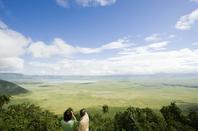
Tanzanian World Heritage Sites
Since 1972, important wilderness and cultural landmarks in the world have been designated World Heritage status by the UNESCO (United Nations Educational, Scientific and Cultural Organization).
Some of the earliest sites include Mount Everest, Machu Picchu, Grand Canyon, Great Wall of China and the Galapagos Islands. The list has grown to over 800 sites around the world. Tanzania currently has seven UNESCO sites, with one designated Cultural and Natural, bringing the total to eight.
UNESCO Sites of Tanzania
- Ngorongoro Conservation Area (Mixed- Natural and Cultural)
- Ruins of Kilwa Kisiwani and Ruins of Songo Mnara (Cultural)
- Serengeti National Park (Natural)
- Selous Game Reserve (Natural)
- Kilimanjaro National Park (Natural)
- Stone Town of Zanzibar (Cultural)
- Kondoa Rock-Art Sites (Cultural)
Tentative World Heritage Sites of Tanzania
- Eastern Arc Mountains Forests of Tanzania
- Gombe National Park
- Jozani - Chwaka Bay Conservation Area
- Oldonyo Murwak
- The Central Slave and Ivory Trade Route
Ngorongoro Conservation Area - Date of Inception 1978
The Ngorongoro Conservation Area is a conservation area which hosts the Ngorongoro Crater -the world's largest unbroken, unflooded volcanic caldera. The crater formed when a volcano exploded and collapsed about two million years ago.
NCA is a unique protected area in Tanzania where conservation of natural resources is integrated with human development. Additionally there are famous archaeological sites in the NCA namely the Olduvai Gorge, Laetoli site, Lake Ndutu site, and the Nasera Rock Shelter. The variety and richness of the fossil remains has made Ngorongoro one of the major areas in the world for research on the evolution of the human species.
The rich pasture and permanent water of the Crater floor supports a large resident population of wildlife. These include wildebeest, zebra, gazelle, buffalo, eland, rhino and warthogs. The swamps and forest is home to hippo, elephant, waterbuck, reedbuck and bushbuck, baboons and vervet monkeys. Lion, leopard, cheetah, and hyena hunt off the abundant wildlife found in the crater.
The World Heritage Committee meeting in Brasilia July 2010 inscribed the Ngorongoro Conservation Area as a cultural property on the World Heritage List. The Committee made its decision because of the extraordinary record of human evolution at the site. The property had previously been inscribed on the list as a natural site.
Archaeological research in the area has also yielded a long sequence of evidence of human evolution and human-environment dynamics, collectively spanning almost four million years to the early modern era. This evidence includes the fossilized footprints at Laetoli, associated with the development of the human ability to walk upright. There are remains that document the development of stone technology and the transition to the use of iron.
The Ngorongoro Conservation Area also contains the spectacular Ngorongoro Crater and the Olduvai Gorge, one of the world's most important pre-historic sites, where anthropologists Louis and Mary Leakey made many of their great discoveries.

 Ngorongoro is a UNESCO World Heritage Site that is located in the Crater Highlands in Tanzania. Ngorongoro has the largest population of pre...
Ngorongoro is a UNESCO World Heritage Site that is located in the Crater Highlands in Tanzania. Ngorongoro has the largest population of pre... The Ngorongoro Conservation Area (NCA) encompasses a large area of the plains on the southern side of the Serengeti and also the Ngorongoro ...
The Ngorongoro Conservation Area (NCA) encompasses a large area of the plains on the southern side of the Serengeti and also the Ngorongoro ...